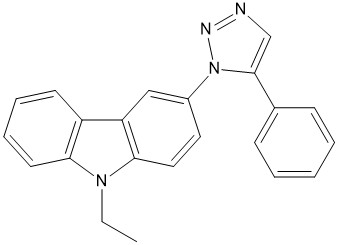MBQ-167 | Dual Rac/Cdc42 inhibitor
NMR (Conforms)

Available Options
| Size: | Price | Quantity | |
|---|---|---|---|
| 5 mg | $80.00 | ||
| 25 mg | $275.00 |
MBQ-167 (2097938-73-1) is a dual inhibitor of the Rho GTPases Rac (IC50 = 103 nM) and Cdc42 (IC50 = 78 nM).1 It inhibits breast cancer cell migration, viability, and mammosphere formation. MBQ-167 induced polarity loss resulting in 95% cell rounding and detachment from the substratum in metastatic MDA-MB-231 cells and was active in GFP-HER2-BM, MDA-MB-468, and Hs578t breast cancer cells as well as Mia-PaCa-2 pancreatic cancer cells, SKOV3 ovarian cancer cells, AGS and NCI-N87 gastric cancer cells, and SH-SY5Y neuroblastoma cells. Non-cancerous mammary epithelial MCF10A and epithelial breast cancer MCF-7 cells were resistant to MBQ-167. MBQ-167 inhibited viability and induced apoptosis in gefitinib and lapatinib resistant SKBR3 breast cancer cells.2 MBQ-167 inhibited triple negative breast cancer tumor growth and lung metastasis in a mouse model.3 Active in vivo.
References/Citations:
- Humphries-Bickley et al. (2017) Characterization of a Dual Rac/Cdc42 Inhibitor MBQ-167 in Metastatic Cancer; Mol. Cancer Ther. 16 805
- Borrero-Garcia et al. (2021) Rac inhibition as a novel therapeutic strategy for EGFR/HER2 targeted therapy resistant breast cancer; BMC Cancer 21 652
- Cruz-Collazo et al. (2021) Efficacy of Rac and Cdc42 inhibitor MBQ-167 in triple negative breast cancer; Mol. Cancer Ther. 20 2420
NMR (Conforms)
Safety Data Sheet:
Product Data Sheet:
Materials provided by Focus Biomolecules are for laboratory research use only and are not intended for human or veterinary applications. Please note that we do not sell to individuals and that all orders placed by non-research organizations will incur a $20 restocking/refund fee
MBQ-167 (2097938-73-1) is a dual inhibitor of the Rho GTPases Rac (IC50 = 103 nM) and Cdc42 (IC50 = 78 nM).1 It inhibits breast cancer cell migration, viability, and mammosphere formation. MBQ-167 induced polarity loss resulting in 95% cell rounding and detachment from the substratum in metastatic MDA-MB-231 cells and was active in GFP-HER2-BM, MDA-MB-468, and Hs578t breast cancer cells as well as Mia-PaCa-2 pancreatic cancer cells, SKOV3 ovarian cancer cells, AGS and NCI-N87 gastric cancer cells, and SH-SY5Y neuroblastoma cells. Non-cancerous mammary epithelial MCF10A and epithelial breast cancer MCF-7 cells were resistant to MBQ-167. MBQ-167 inhibited viability and induced apoptosis in gefitinib and lapatinib resistant SKBR3 breast cancer cells.2 MBQ-167 inhibited triple negative breast cancer tumor growth and lung metastasis in a mouse model.3 Active in vivo.
References/Citations:
- Humphries-Bickley et al. (2017) Characterization of a Dual Rac/Cdc42 Inhibitor MBQ-167 in Metastatic Cancer; Mol. Cancer Ther. 16 805
- Borrero-Garcia et al. (2021) Rac inhibition as a novel therapeutic strategy for EGFR/HER2 targeted therapy resistant breast cancer; BMC Cancer 21 652
- Cruz-Collazo et al. (2021) Efficacy of Rac and Cdc42 inhibitor MBQ-167 in triple negative breast cancer; Mol. Cancer Ther. 20 2420
Calculate the molar concentration, mass or volume in a solution.
Concentration × Volume × Molecular Weight = Mass
Focus Biomolecules • Plymouth Meeting, PA USA • 1-855-FOCUS21
Focus Biomolecules
Plymouth Meeting, PA USA
1-855-FOCUS21
Website Created by Advanta Advertising LLC.

